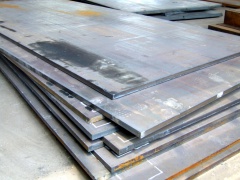Difference between revisions of "Steel plates"
(Created page with "{{Infobox_Miscellaneous | image = Steel plates.jpg | origin = | stowage factor = | humidity a...") |
m |
||
| Line 1: | Line 1: | ||
{{Infobox_Miscellaneous | {{Infobox_Miscellaneous | ||
| image = Steel plates.jpg | | image = Steel plates.jpg | ||
| − | | origin = | + | | origin = - |
| − | | stowage factor = | + | | stowage factor = 0,48 m<sup>3</sup>/t (bundles) |
| − | | humidity and moisture = | + | | humidity and moisture = - |
| − | | ventilation = | + | | ventilation = - |
| − | | risk factors = | + | | risk factors = See text |
}} | }} | ||
| + | ==Description / Shipment / Storage== | ||
| + | Sheet metal is metal by an industrial process into thin, flat pieces. It is one of the fundamental forms used in metalworking and it can be cut and bent into a variety of shapes. Countless everyday objects are constructed with sheet metal. Thicknesses can vary significantly, extremely thin thicknesses are considered foil or leaf, and pieces thicker than 6 mm (0.25 inch) are considered plate. | ||
Revision as of 10:08, 13 August 2014
| Infobox on Steel plates | |
|---|---|
| Example of Steel plates |  |
| Facts | |
| Origin | - |
| Stowage factor (in m3/t) | 0,48 m3/t (bundles) |
| Humidity / moisture | - |
| Ventilation | - |
| Risk factors | See text |
Steel plates
Description / Shipment / Storage
Sheet metal is metal by an industrial process into thin, flat pieces. It is one of the fundamental forms used in metalworking and it can be cut and bent into a variety of shapes. Countless everyday objects are constructed with sheet metal. Thicknesses can vary significantly, extremely thin thicknesses are considered foil or leaf, and pieces thicker than 6 mm (0.25 inch) are considered plate.











